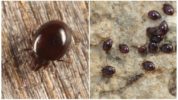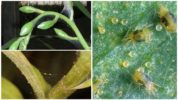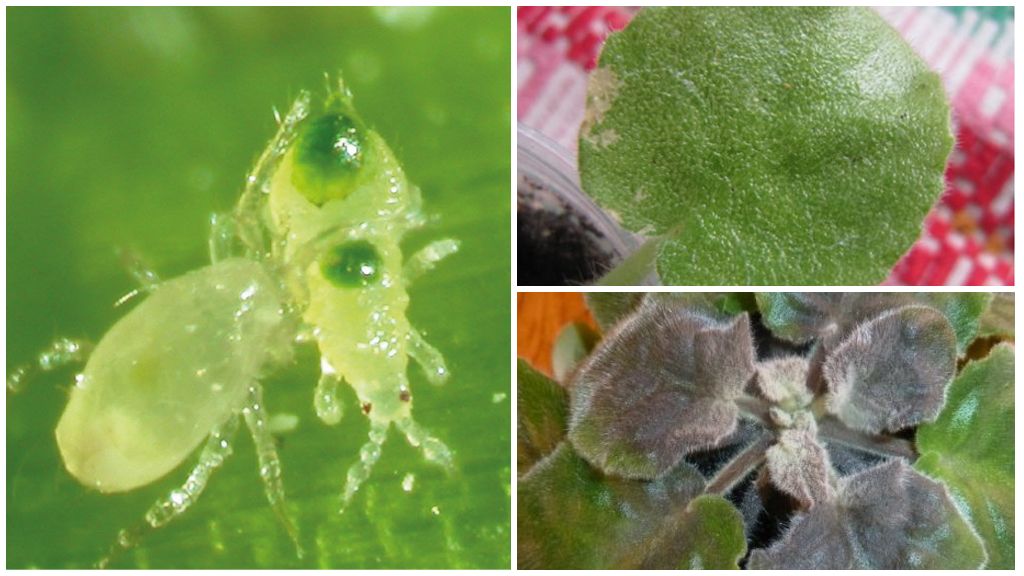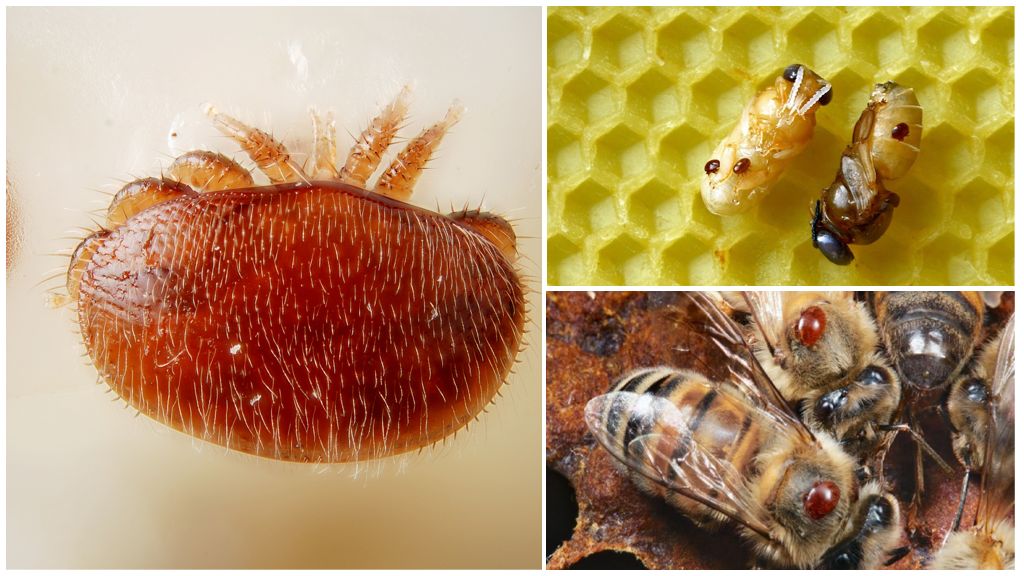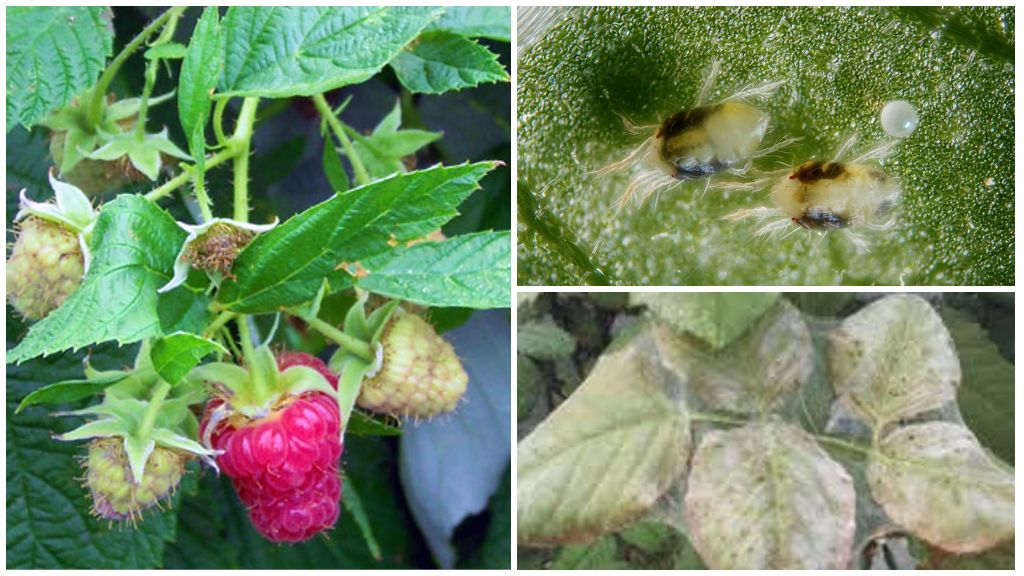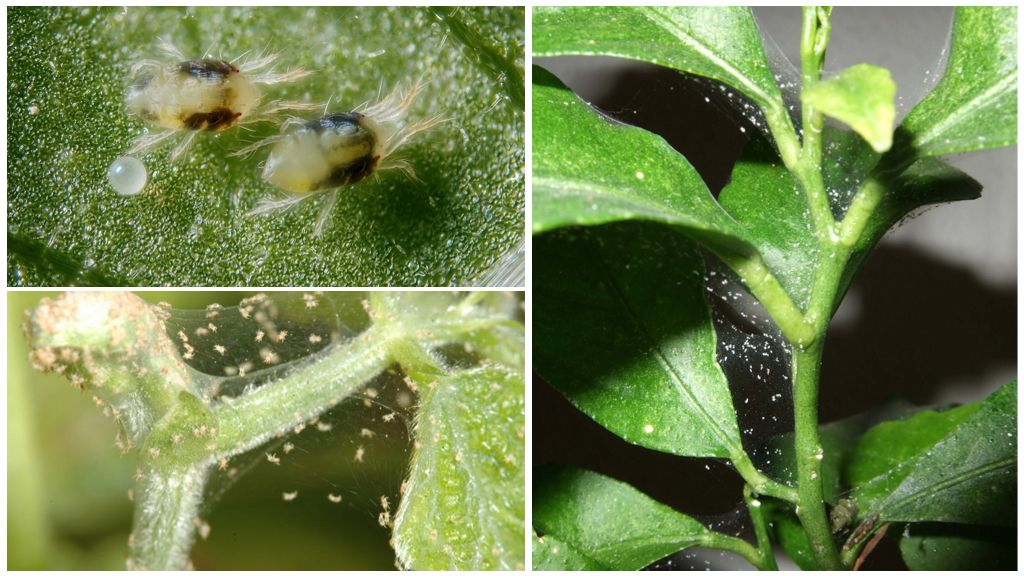- Shell mite on an orchid
- Shell Mites
- Armor tick control agents
- Orchid spider mite
- Spider Mite Remedies
Despite the apparent fragility, a delicate, beautiful orchid is very hardy. But in order for it to delight others with its marvelous flowers, the plant needs careful care. For her, it is necessary to choose the optimal temperature, humidity, light, water on time. Orchid, like any green plantation, is periodically subjected to arthropod attacks. The troubles are delivered to her by a spider mantle and carapace.
Differences between shell and spider mites
There are many species of shell mites, scientists have more than 6,000 species of these arthropods. On orchids, you can see almost any of them, but the most common are small black shiny round ticks. Basically, they choose substrates based on bark. The mite carapace, unlike the cobweb arthropod, does not cause particular harm to orchids; it is, as it were, its good neighbor. This species does real harm when the colony reaches catastrophic numbers, which is extremely rare. The differences between these two types of ticks are summarized in the table.
| Spider web | Armored |
|---|---|
| Color: whitish, dirty gray, sand, light brown, yellowish with brown spots. The average size of adults reaches 01-0.3 mm. | The body color is black or dark brown. Its sizes are from 0.7 to 0.9 mm. Brown or tan eggs can be seen with the naked eye. |
| Slow arthropods, able to creep 5 mm in 1-2 minutes. Most often they sit motionless. | Pretty nimble ticks. In one second they are able to overcome 5-7 mm. |
| Despite the fact that spider mites are not afraid of light, they settle on the back of the sheets, they are easily held there. | They do not like light and, when it appears, run away to secluded places. |
| They spread throughout the plant, lay their eggs on green leaves, shoots, stems. | They also prefer to crawl throughout the plant. For laying eggs, fallen leaves, rotten roots, twigs located in the ground, i.e. decaying organic matter, are chosen. |
| For the development of spider mites, the humidity of the soil and air does not matter. | The development of armored arthropods occurs only in moist soil, in a moist environment. |
Shell mite on an orchid
Carapace mites belong to the order Oribatida. The development feature is 5 postembryonic active stages of the life cycle:
- larva;
- nymph (3 stages);
- adult individual.
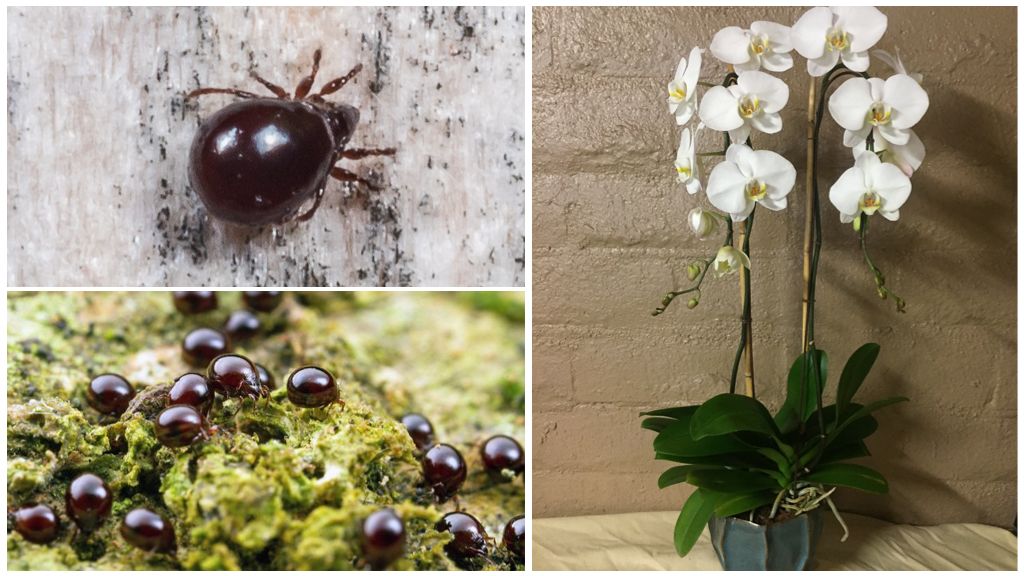
At all stages, they feed on a variety of materials that are part of the humus: carrion, lichens, dead, fungal organisms, algae. Their metabolic rate and fertility are low, development is slow. The time from an egg to an adult can range from several months to two years.
On a note!
During feeding, carapace mites can swallow helminth eggs, which hatch right in their body.
What harm does the shell mite do?
This kind of ticks does not bring obvious harm to orchids and other plants. But, being carriers of helminths, it is better not to allow them to orchids. Harmful bacteria gather on the legs of arthropods, crawling throughout the plant, they climb into a variety of places, including a fresh scrape of a leaf that has fallen off, a spine, spreading microbes. As soon as white ticks appear on the flowers, immediate action is needed. If the plant has such damage, they should be treated. To do this, use colloidal sulfur, crushed birch charcoal.
Important!
If deformation is noticeable on the top of the head, curvatures on young leaves are detected, damage is caused by unanimous arthropods. These are the so-called Polyphagotarsonemus latus - wide mites of microscopic dimensions, which can only be seen through a microscope. They have poisonous saliva. Signs of damage are similar to burns.
If there are a lot of shell mites in pots with orchids, this indicates that the earth is very damp. As a result, fallen leaves, twigs, sticks that were in the ground rot in it. This suggests that fungi and bacteria are actively multiplying in the soil, which can cause significant harm to the plant. To get rid of the carapace mite on an orchid, it is necessary to sprinkle the substrate on a baking sheet, a layer of about 5 mm and heat it in the oven for half an hour at a temperature of 200 ° C.
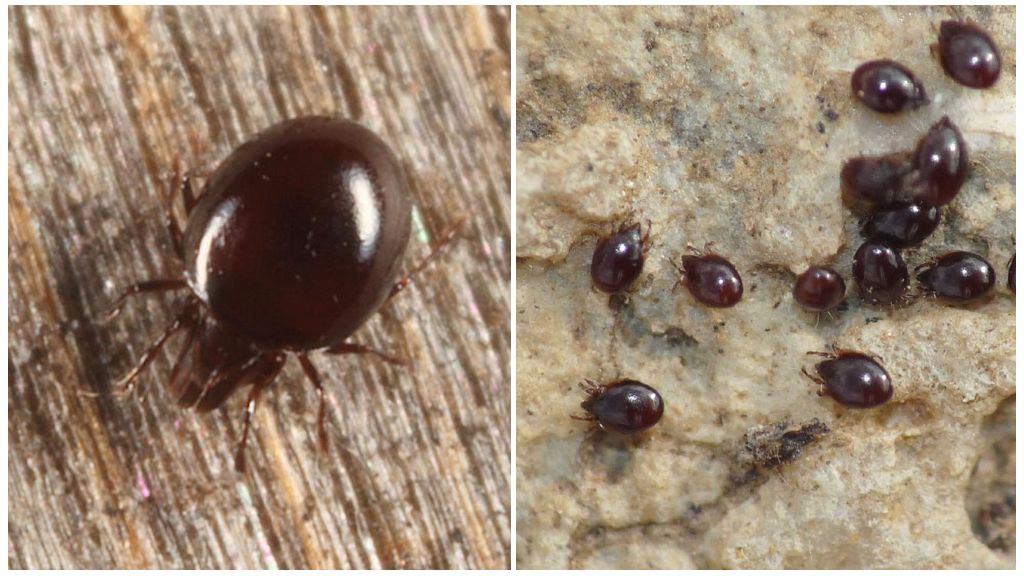
With a huge accumulation of shell mites, it is recommended to transplant an orchid, otherwise the root will die. This is an emergency measure, but it must be taken. To do this, remove the orchid from the pot and rinse it thoroughly in hot water. The plant calmly tolerates a water temperature of 40-50 ° C. It is better to take a large container so that you can freely move the flower. Water needs to be changed 3-4 times. Mites hidden from daylight will wash the water. Immediately, the orchid is not planted in the substrate, it should be well dried. Soil also needs to be freed from parasites with the help of high temperatures. The orchid can be kept for several days without a substrate, repeating the rinse procedure. The roots will absorb fresh air.
Feedback
In the spring planted seedlings of cucumbers. Nearby were pots of orchids. Anfiska cat lives in my house. She cut off several branches of cucumbers and ate orchids. Gathering what was left of the flower, put it in a box with cucumbers. Since cucumbers were watered abundantly, it is not surprising that a favorable environment for shell mites was created. They moved to the orchid. I did not begin to clean it and after a week I noticed that there were new shoots. No harm to the flower, the fast moving round black "balls" did.
Eugene, Vladimir
Shop preparations
You can fight with a tick with the help of chemicals. For this purpose, it is recommended to buy acaricides. Well proven such means:
- Fitoverm. It is necessary to prepare the solution according to the instructions and spray the plant with it. The cost of 1 ampoule (4ml) 9-15 rubles .;
- Vermitek. Concentrate in the form of an emulsion. The container contains 2 ml of insectoacaricide, the price is about 35 rubles. Dilute it in 1 liter of water and spray the plant, after which put a plastic bag on it, which is removed after 24 hours.
- Nisoran. The package contains 2 g of the substance, the cost of 65 rubles. It has an effect on nymphs and larvae. Adults continue to live by laying eggs. To destroy them, you must connect another drug, such as Sunmayt. It is sold in packaging (500 g), the price is about 110 rubles .;
- Apollo The drug is in the form of a concentrate. The container contains 2 ml, the price is 30 rubles. It destroys eggs, does not kill adults, but sterilizes them. Ticks die within 7 days.
- Tick-borne, Anti-tick.

On a note!
Actara drug on arthropods does not have the desired effect.
You can get rid of a large number of shell mites by laying cucumber, potato or apple peels on the soil surface.Parasites will not die, but in the colony they will become much smaller.
Feedback
I do not use chemicals, but I watch the earth very carefully. I pour orchids with water at room temperature infrequently, but abundantly and only when the substrate is completely dry. There were no problems so far.
Olga, Voronezh
Orchid spider mite
Body in spider mite has an oval shape, its color depends on what it eats. It can be whitish, reddish brown, dirty yellow. If you carefully look at the photos of ticks on orchids, you can see that an adult has 4 pairs of legs with five segments on each. The tick weaves a very thin web, which envelops the leaves, stems and flowers of plants, including an orchid. Under it, the rapid multiplication of parasites occurs. Only 10-20 days pass from the moment of masonry to puberty. The process depends on the environmental conditions in which spider mites live. The appeared larvae have only 3 pairs of legs, after several lines a fourth appears. Life expectancy is only 5 days.
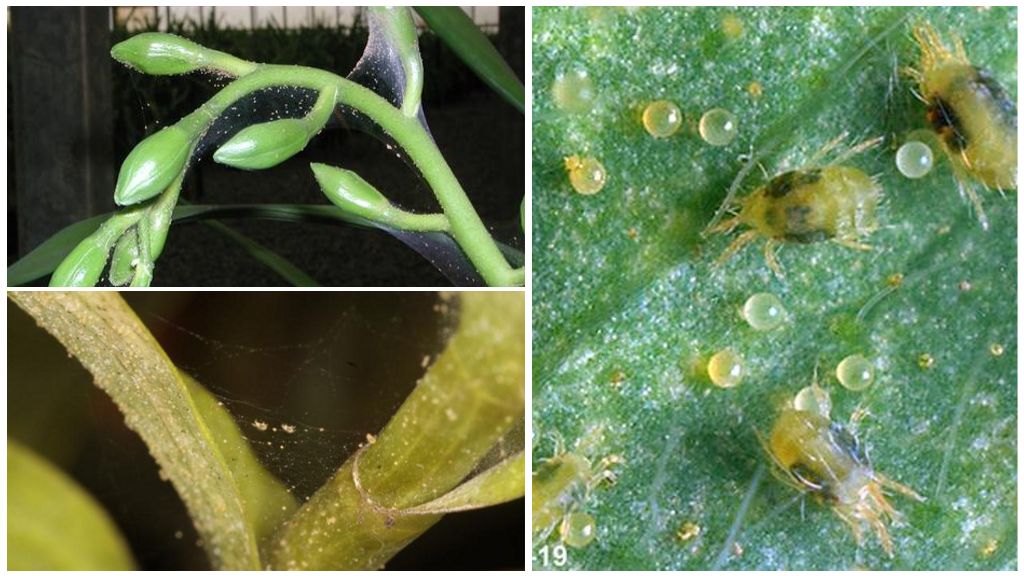
Important!
Warm dry climate - ideal conditions for the development of spider mites. As soon as humidity rises, young individuals develop much more slowly. This is a good reason to start the fight against spider mites on orchids.
Damage to Orchids by Spider Mites
Parasites feed on plant sap. Puncturing leaves or stems, they introduce into the plant a special substance that destroys cell membranes. A spider web appears on the leaves, they turn yellow and fall off. With a large number of spider mites, a spider web appears on the buds of orchids. The leaves in this case turn yellow faster, fall off and the plant dies.
On a note!
Spider mites transmit fungal, viral and bacterial diseases to the plant. This leads to the fact that dark spots, weeping areas can also appear on it. When the juice is exhausted and the infection is transmitted, an orchid disease called gray rot occurs.
It is difficult to consider spider mites with unarmed gas, here you can see the web. If it is slightly pressed down, the eggs will be crushed and a reddish liquid will appear. It is necessary to take measures to combat the spider mite on the orchid.
How to get rid of parasites
A spider mite on an orchid can be destroyed in many ways. First you should wipe the affected plant well. The more thoroughly this is done, the more eggs and adults can be removed. It is necessary to process the orchid with the help of liquid or laundry soap. In 1 liter of water add 1 tbsp. a spoonful of ingredient. Using a sponge moistened in a solution, the surface of the stem and each leaf should be treated.
Important!
Soap solution should not get to the roots, so you need to process the orchid very carefully.
After this, you need to pour the substrate with a soapy solution, cover the flower with a plastic bag and leave for 3-4 days. As a result of increased humidity, spider mites will die.
Important!
The pot with the orchid should be in the shade, the ultraviolet heats the soil, the temperature rises, which will lead to the death of the flower, it just sprays.
Chemicals
The following products have proven their effectiveness:
- Actellik. The drug is sold in a package of 2 ml, price - 27 rubles. Flowers are sprayed with a solution prepared according to the instructions.
- Neoron The cost of one ampoule (12.5 ml) - from 70 to 120 rubles. It has an instant effect. It is necessary to apply immediately after preparation of the solution.
- Fitoverm. The drug created on the basis of aversectin has an effective effect on combating spider mites on indoor plants. Penetrating into the body through the intestinal tract, it has a negative effect on the nervous system of parasites. It goes on sale in bottles and ampoules (2 ml, costing about 15 rubles). To prepare the solution, the contents of the ampoule must be dissolved in 1 liter of water. The resulting composition is sprayed with a plant.
- Karbofos.The active substance is malathion. It has a quick effect on ticks. A package containing 30 g of the product costs about 30-32 rubles. The solution is prepared on the basis of instructions.
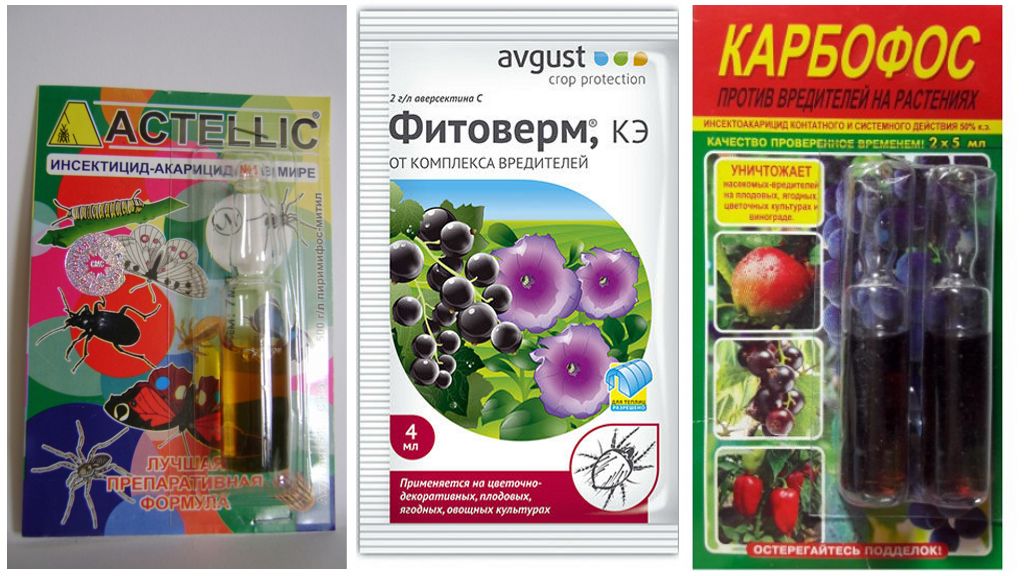
On a note!
The viability of the spider mite is high, it quickly develops resistance to the effects of drugs. It is recommended that chemicals be changed periodically.
Folk preparations
You can get rid of ticks on an orchid using simple and affordable means.
Well help infusions and decoctions prepared from plant ingredients.
- Grind 2 heads of garlic, pour one liter of water and insist in a dark place for 5 days. After this, the resulting mixture should be filtered, the same amount of water added and sprayed with the resulting orchid solution.
- Dry mustard in an amount of 60 g diluted in a liter of water and insist 3 days. The finished composition is treated with plants.
- 100 g of onion husks are poured with 5 liters of water, insist 5 days. A filtered solution is applied to the affected areas of the orchid.
- The roots and leaves of dandelion are poured with a liter of hot water, insist 3 hours. Use strained infusion to treat the affected areas.
Feedback
I always use only folk remedies. I regularly conduct treatment with soapy water, used onion husks for spraying, carefully monitor the watering.
Marina, Kharkov
On orchids, a root tick is found. It is often called onion or bulb (Rhizoglyphus echinopus). The body has the shape of an ellipse, color - white, light yellow, legs strong brown shades. It is almost impossible to detect, since it lives at the base of the roots.

